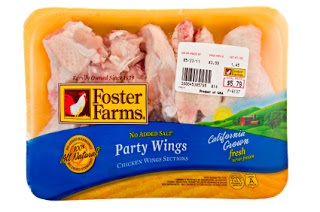 |
| Not my kind of “party” |
Many people who watched Food Inc. saw chickens packed in dark, dirty pens, walking in each others’ feces and swore off chicken. On the other hand, maybe you blocked those images out and remain unconvinced of any danger. Well, if you thought salmonella, arsenic, injected hormones or chlorine baths were your biggest concerns with feedlot chicken, think again. Researchers found that the culprit for almost all UTIs (urinary tract infections) in women isn’t from “holding it” or improper wiping but chicken. Yup, that chicken and broccoli may contain an extra ingredient namely E. coli bacteria.
I love skeptics. If you’re reading and wondering how the E. coli was traced to chicken, I’ll explain. Researchers from McGill look at the bacteria from women in California and Canada and played a little genome matching game with bacteria found in beef, pork and chicken. There is E. coli in other meat but it’s good old chicken that most closely resembles that in UTIs. And the icing on the vile cake? Due to the overuse of antibiotics in factory farms many strains of E. coli are antibiotic resistant. The study was published in the March issue of the CDC’s Emerging Infectious Diseases.
From CDC website:
Every year, 6–8 million cases of uncomplicated urinary tract infections (UTI) occur in the United States; greater than 80% are associated with E. coli. The urinary tract is the most common source for E. coli causing bloodstream infections, which cause 40,000 deaths from sepsis each year in the United States. Drug-resistant infections often require more complicated treatment regimens and result in more treatment failures.
This “extraintestinal E. coli” is somewhat less lethal than the 0157 strain that is responsible for many food recalls but “may kill you but chance is lower” doesn’t reassure me. Additionally, this bacteria can lay dormant for six months before causing problems, what about the effects for children? A friend (who recently mentioned she had a UTI) upon reading this information said, “Is anything safe to eat?” I hear that a lot and the truth is yes… but you have to do your homework. A few options:
- I get it if you’re repulsed. How can you not be? These poor chickens peck at droppings from their fellow birds or drink water contaminated by stool. If sayonara chicken is what feels right, that’s one option
- Organic Chicken– chickens are not given antibiotics. Increasingly, probiotics and essential oils are being used to reduce bacteria content naturally. They are also less cramped and therefore much less likely to be contaminated. I will not eat chicken that’s not organic and do not serve it to my family. In addition to organic or the next best thing is “Certified Humane” . Unfortunately there are many loopholes around “raised without antibiotics.” For example, some companies inject chickens before they hatch (seriously). Other producers, same name as a well-known sketchy boxer, use drugs that aren’t technically antibiotics but ionophores. Once you’re dealing with this kind of deceit, I’m shopping elsewhere.
- Cook properly– this is often put out there as a way to prove sub par chicken is safe. If you just cook it to the proper temperature (165 Fahrenheit for chicken) everything is killed off. Well maybe not everything there’s still the arsenic and antibiotics. Did I mention my husband and I happen to be doing a raw, vegan week? No “dark” meat chicken for us.
Do you eat chicken? Are you selective about where it comes from? What do you do at restaurants? Which option above 1, 2 or 3 works for you?

